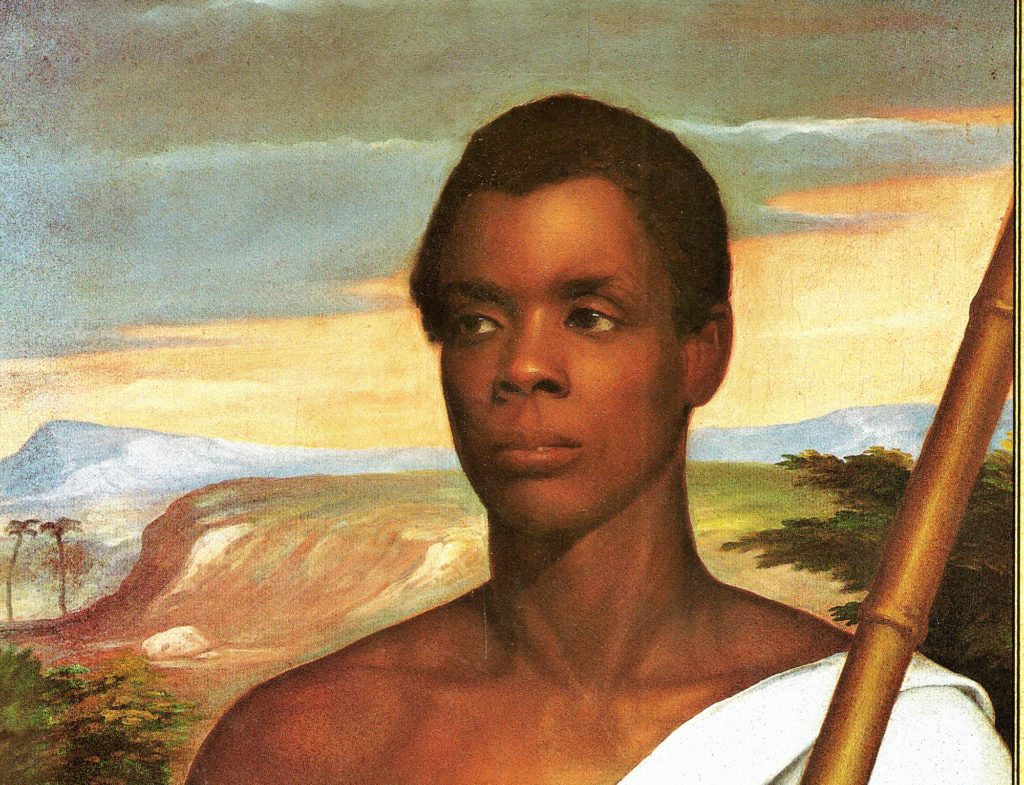The Amistad Captives

Portrait of Cinque by Nathaniel Jocelyn (January 31, 1796 – January 13, 1881)
From March through November 1841, Farmington was home to the African Mendi captives who had rebelled and overtaken the slave-ship, La Amistad. The 53 captives, mostly Mendi from what is now Sierra Leone, had been captured and shipped to Cuba. In 1839, they were sold to work plantations on the other side of Cuba. They were shipped aboard La Amistad. While at sea, they rebelled and the 44 survivors sailed the ship to Long Island, New York. They were taken into custody aboard the USS Washington under the command of Lt. Gedney. They were jailed in New Haven and taken to trials in Hartford and Washington, DC. The trials lasted 18 months. In February 1841 their case was argued by former President John Quincy Adams before the Supreme Court. On March 9, 1841 the decision came down, declaring the Africans to be free people with permission to return to their homeland. Nine days later, they arrived in Farmington, where abolitionists provided housing, schooling, and the fundraising necessary for the Mendis passage back to their homeland.
| Farmington, Connecticut: The Village of Beautiful Homes | Farmington Historical Society (Reprint) | 1906 |
| The Diaries of Julia Cowles, a Connecticut Record, 1797 – 1803 | Julia Cowles | 1931 |
| A Short History of Farmington, Connecticut | Lydia Hewes | 1935 |
| The Underground Railroad in Connecticut | Horatio T. Strother | 1962 |
| Farmington In Connecticut | Christopher Bickford | 1982 |
| Farmington, Connecticut, A Journey of 360 Years | Ernest R. Shaw | 1995 |
| Amistad Sites (The Lost Eight Months) and Underground Railroad Locations: Farmington, CT | Ernest Shaw | 1997 |
| Speaking for Ourselves, African American Life in Farmington Connecticut | Barbara Donahue and the Farmington Historical Society Research Team | 1998 |
| Amistad, A Long Road to Freedom | Walter Dean Meyers | 1998 |
| Images of America: Farmington, Jean M. Martin, 1999. | Jean M. Martin | 1999 |
| Farmington’s Freedom Trail: The Amistad Story and the Underground Railroad | Marguerite Yung and Jean B. Johnson | 2005 |
| Images of America: Unionville | Clifford T. Alderman | 2010 |
| # American to the Backbone, the Life of James W. C. Pennington, the Fugitive Slave who became one of the First Black Abolitionists | Christopher L. Webber | 2011 |
| The Amistad Rebellion | Marcus Rediker | 2012 |
| Africa is my Home, a Child of the Amistad | Monica Edinger | 2013 |
| African American Connecticut Explored | edited by Elizabeth J. Normen, with Stacey K. Close, Katherine J. Harris, and Wm. Frank Mitchell | 2013 |
| # Gateway to Freedom, the Hidden History of the Underground Railroad | Eric Foner | 2015 |
| Art of the Amistad and the Portrait of Cinque | Laura A. Macaluso | 2016 |
| Farmington, Connecticut: 350 Years In Pictures | Farmington 350th Anniversary Committee. | |
| Farmington: New England Town Through Time | Barbara Donahue, photograps by Saren Langmann | |
| The Heritage Trail Guidebook: Farmington, CT | Farmington Public Schools | |
| Wikipedia.org: Pages include: http://en.wikipedia.org/wiki/Underground_Railroad | ||
| # these two don’t talk about Farmington specifically, but are good background books. |


